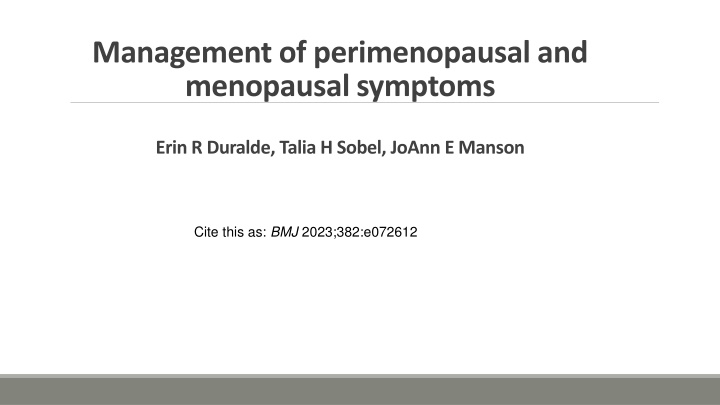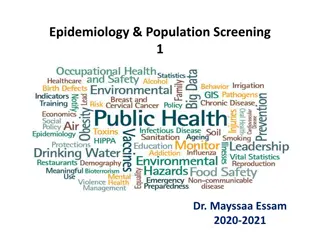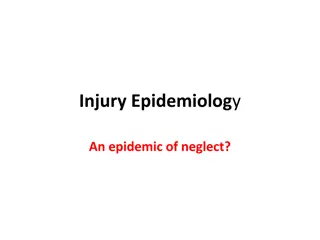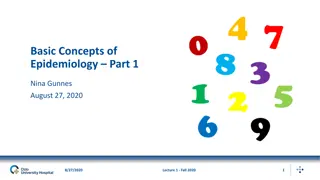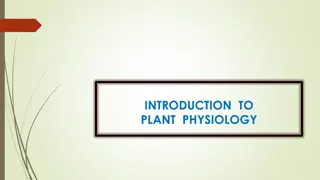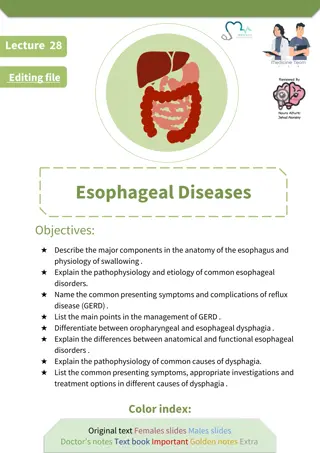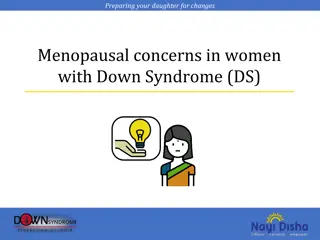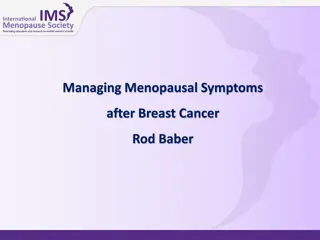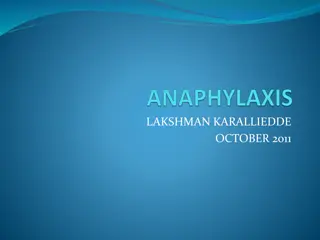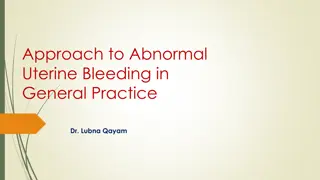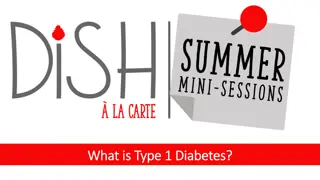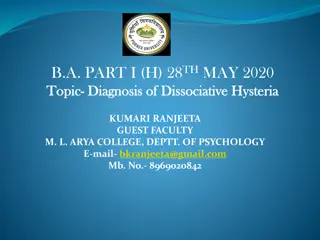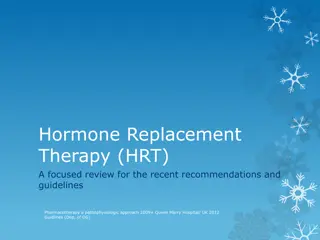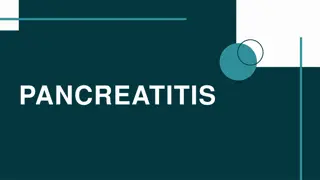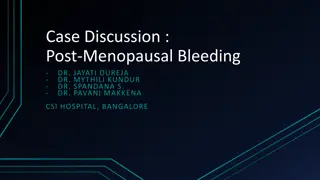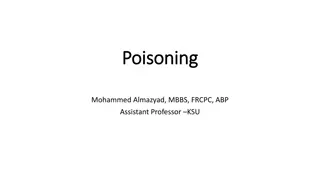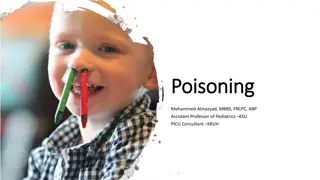Managing Menopausal Symptoms: Epidemiology, Physiology, and Treatment Approach
Many women experience bothersome symptoms during menopause transition, leading to unnecessary outpatient visits, prescriptions, and negative impacts. Understand the epidemiology, physiology, and treatment options through recent research findings.
Download Presentation

Please find below an Image/Link to download the presentation.
The content on the website is provided AS IS for your information and personal use only. It may not be sold, licensed, or shared on other websites without obtaining consent from the author.If you encounter any issues during the download, it is possible that the publisher has removed the file from their server.
You are allowed to download the files provided on this website for personal or commercial use, subject to the condition that they are used lawfully. All files are the property of their respective owners.
The content on the website is provided AS IS for your information and personal use only. It may not be sold, licensed, or shared on other websites without obtaining consent from the author.
E N D
Presentation Transcript
Management of perimenopausal and menopausal symptoms Erin R Duralde, Talia H Sobel, JoAnn E Manson Cite this as: BMJ 2023;382:e072612
Introduction Many women experience pronounced symptoms during and after the menopause transition. Studies show that 60-86% of women experience symptoms so bothersome that they seek medical care.
Introduction Undertreated menopausal symptoms: have been associated with 1.5 million otherwise unnecessary outpatient visits annually. 26-33 million prescriptions for non-regulated treatments (costing more than $1bn annually) and negative effects on sleep, metabolism, mental health, personal relationships, and work productivity.
Agenda Epidemiology and physiology of menopause Treatment approach by symptom or sign Menopausal hormone therapy Considerations for special populations
Sources and selection criteria We considered studies published between 1 January 2012 and1 November 2022 to include the most up-to-date research. We searched PubMed using the following terms; menopause, perimenopause, menopause transition, premature menopause, early menopause, primary ovarian insufficiency, surgical menopause, oophorectomy; vasomotor, hot flashes,
Epidemiology and physiology of menopause In 2021 an estimated 1.02 billion women were postmenopausal globally, with 1.65 billion anticipated by 2050. The menopause transition; consists of perimenopause and the first 12 months after the final menstrual period (FMP),which can last for as long as 10 years.
Epidemiology and physiology of menopause The onset of the transition is marked by: changes in menses and/or development of hypoestrogenic symptoms such as hot flashes, mood changes impaired concentration and memory sleep disturbance fatigue reduced libido joint pain and increased central adiposity
Epidemiology and physiology of menopause The average age of menopause is 51 years. 70% of women enter menopause early between ages 40 and 45 and 1.9% enter before age 40, which is considered premature menopause. The symptoms of natural menopause can last from 3 years to more than 11 years. 20% of women experience hot flashes into their late 50s, 10% into their late 60s, and 5% into their 70s.
Epidemiology and physiology of menopause Decision making about treatment is influenced by many factors, including: severity of symptoms stage of menopause need for perimenopausal contraception presence of premature or early menopause Comorbidities The patient s personal preference about treatment
Menopausal hormone therapy Systemic menopausal hormone therapy: is the most effective treatment for symptoms caused by low estrogen, Estrogen therapy alleviates vasomotor and many other menopausal symptom. To mitigate the risk of endometrial hyperplasia and malignancy in women with a uterus: a progestogen must be added. This can be cycled or given continuously.
Indications for use Hormone therapy is indicated: to treat hot flashes Genitourinary syndrome of menopause to prevent osteoporosis Premature and early menopause should be treated with hormone therapy until the average age of menopause
Hormone therapy contraindications and comorbidities Contraindications Breast cancer Endometrial cancer (advanced stage hormonal or non-hormonal) Untreated endometrial hyperplasia or cancer Unexplained vaginal bleeding Myocardial infarction, stroke, or transient ischemic attack Uncontrolled hypertension
Hormone therapy contraindications and comorbidities Contraindications Peripheral artery disease Unprovoked venous thromboembolism Known clotting disorder Cirrhosis Active hepatitis Porphyria cutanea tarda
Hormone therapy contraindications and comorbidities Comorbidities of concern Controlled hypertension Hyperlipidemia Diabetes Smoking Provoked venous thromboembolism Chronic inflammatory states HIV Gallbladder disease Ovarian or cervical cancer with suspected hormone responsiveness
Cardiovascular risk and the timing hypothesis The first Women s Health Initiative (WHI) publication showed concerning increased rates of venous thromboembolism and cerebrovascular disease, but age stratification revealed significant differences in cardiovascular disease outcomes.
Cardiovascular risk and the timing hypothesis Menopausal Hormone Therapy and Long-term All-Cause and Cause- Specific Mortality: The Women's Health Initiative Randomized Trials Randomized Controlled Trial DOI: 10.1001/jama.2017.11217 JoAnn E Manson1, Aaron K Aragaki2, Jacques E Rossouw3, Garnet L Anderson2,
Cardiovascular risk and the timing hypothesis At 18 year follow-up women aged 50-59 years in both treatment groups, had no increase in all cause, cardiovascular, or cancer mortality.
Cardiovascular risk and the timing hypothesis A potential explanation for the timing hypothesis is that women in early menopause have healthier blood vessels, which undergo vasodilation and experience overall anti-inflammatory effects in response to estrogen. With age, the vasculature becomes more stenotic as a result of plaque accumulation, and the damaged endothelium has impaired vasodilation; on this substrate, estrogen has pro-inflammatory effects and can destabilize plaques.
Breast cancer risks Hormone therapy should be avoided in women who have had breast cancer, as its use has been associated with increased risk of recurrence. who have not had breast cancer, some formulations of hormone therapy may increase the absolute risk by a small amount, depending on formulation and duration.
Breast cancer risks Table 1; provides a comparison of findings on breast cancer from the 20 year follow-up of the WHI s RCTs and the Collaborative Group on Hormonal Factors in Breast Cancer (CGHFBC) s meta-analysis of 58 prospective and retrospective observational studies of long term effects of hormone therapy on breast cancer.
Table 1; Comparison of WHI and CGHFBC findings on hormone therapy and breast cancer Characteristic WHI 20 year follow-up CGHFBC Study type RCT Nested case-control meta-analysis No of participants CEE trial: 10 739; CEE+MPA trial: 16 608 Breast cancer cases: 128 435; controls: 366965 Estrogen alone CEE CEE, estradiol Estrogen+progestogen CEE+MPA CEE, estradiol; levonorgestrel, MPA, NETA; small No with dydrogesterone, micronized progesteron Comparator groups Women with hysterectomy: CEE v placebo; women with uterus: CEE+MPA v placebo Current users v never users; past users v never users; subdividedby treatment type Outcomes Primary: heart disease; secondary: osteoporosis; primary adverse event: incident invasive breast cancer Primary: incident invasive breast cancer Mean duration of use, years: Estrogen alone;7.2y Estrogen+progestogen;5.6y Ranges from 10.7 years for those starting age 40-44 to 7.9 years for age 60- 69
Table 1; Comparison of WHI and CGHFBC findings on hormone therapy and breast cancer Characteristic WHI 20 year follow-up CGHFBC Relative risk of invasive breast cancer, HR (95% cI) Estrogen alone All durations: 0.78 (0.65 to 0.93) 1-4 year use current use: 1.17 (1.10 to 1.26); past use: 1.04 (0.98 to 1.11) 5-9 year use current use: 1.22 (1.17 to 1.28); past use: 1.09(1.03 to 1.15) Relative risk of invasive breast cancer, HR (95% CI): Estrogen+progestogen All durations:1.28(1.13 to 1.45) 1-4 year use current use: 1.60 (1.52 to 1.69); past use: 1.10 (1.05 1.16) Relative risk of breast cancer mortality, HR (95% CI): Estrogen alone 0.60(0.37 to 0.97) Did not evaluate mortality Relative risk of breast cancer mortality, HR (95% CI): Estrogen+progestogen 1.35(0.94 to 1.95) Did not evaluate mortality Absolute risk of invasive breast cancer Estrogen alone Estrogen+progestogen Reported:per10000person/y -7 9 Estimated cases per 100 people using HT for 5 years starting at age 50, over 20 year follow-up 0.5 1.4(cycled);2(continuos) Absolute risk of breast cancer mortality -2 0 Did not evaluate mortality
Treatment considerations by menopause phase Premature and early menopause Women with premature or early menopause due to primary ovarian insufficiency, bilateral oophorectomy, radiation/chemotherapy, or other causes should receive hormone therapy to support cardiovascular, genitourinary, bone and cognitive health until the average age of menopause.
Treatment considerations by menopause phase Premature and early menopause Women with premature menopause who do not receive hormonal replacement have increased rates of dementia, parkinsonism, mood disorders, cardiovascular disease, osteoporosis,sexual dysfunction, and overall mortality. Higher doses of estrogen are needed than would be used to treat symptoms in women closer to the average age of menopause, and both combined hormonal contraceptive (CHC) and hormone therapy should be considered. .
Perimenopause During perimenopause, women can ovulate up until their FMP. Contraception is particularly important because pregnancy in perimenopause is associate with higher risk for maternal and fetal complications. The best contraceptive option should consider the woman s hormonal milieu, perimenopausal symptoms, comorbidities, drug treatments, and personal preferences (supplementary table A).
Supplementary Table A. Preferred contraception in perimenopause1 Type Formulations Hormone Route Dose range Side effects CHC Oral EE + Drospirenone Desogestrel Oral Varies by contraception. 0.1- 0.2mg/day EE tends to be better tolerated than 0.3mg Abnormal bleeding, weight gain, breast tenderness, mood changes, headaches, nausea, bloating, decreased libido Supplementary Table A. Preferred contraception in perimenopause1 Ethynodiol Diacetate Levonorgestrel Norethindrone NETA Norgestimate Norgestrel EE Norelgestromin EE Levonorgestrel 0.035 mg/day 0.15 mg/day patch Transdermal Abnormal bleeding, mood changes, weight gain, breast pain, headache, nausea 0.03 mg/day 0.12 mg/day
Supplementary Table A. Preferred contraception in perimenopause1 Formulations Type Hormone Route Side effects Dose range CHC Vaginal Ring EE Etonogestrel 3-month EE Segesterone acetate 12-month Vaginal 0.015mg/day 0.120 mg/day Abnormal bleeding, vaginitis, headache, weight gain, decreased libido 0.013 mg/day 0.15 mg/day POP Norethindrone 0.35 mg/day Nausea, headache, irregular bleeding, breast tenderness Acne, Progestin only Oral Drospirenone 4 mg/day Subdermal implant Etonogestrel Subdermal 68 mg Irregular bleeding. IUS Levonorgestrel Uterine 52mg,19.5,13.5 Light bleeding, amenorrhea
Perimenopause Hormone therapy should not be used as contraception, as it rarely suppresses ovulation or alters cervical mucus substantially. For those who do not smoke and have no history of venous thromboembolism or stroke, low dose CHC pills are appropriate. CHCs contain ethinyl estradiol which is associated with higher rates of venous thromboembolism and stroke compared with the estradiol and CEEs used in hormone therapy. Progestin-only options have fewer contraindications and low dose estradiol can be added if vasomotor symptoms are prominent
When to switch from contraceptive method to hormone therapy When a woman who menstruates is no longer fertile is difficult to ascertain. However, the recommendations in table 2 may assist in determining when contraception is no longer needed.
Table 2 | Determining when to discontinue contraception Table 2 | Determining when to discontinue contraception Current method Clinical evaluation Laboratory evaluation Contraception plan Non-hormonal contraception Amenorrhea for 12-24 months - None needed CHC Age 50 Stop CHC for 6 weeks; use non- hormonal contraception. Check FSH twice 4-8 weeks Apart If FSH >30 IU/L both times, contraception is no longer needed. If FSH <30 IU/L either time, resume CHC and repeat approach in 1 year Stop CHC at age 55 Spontaneous conception very rare Depot medroxyprogesterone acetate Check FSH on same day as and before DMPA dose twice If FSH >30 IU/L on two occasions, can discontinue Progestin implant, IUS, POP Check FSH at any time while on progestin method. If FSH >30 IU/L, continue method for 1 more year, then discontinue Other May stop all methods without laboratory evaluation. However, if menses resume, consider FSH testing and resumption of contraception
Postmenopause Decision making differs according to whether it is a new start or continuation of hormone therapy (see fig 2 and fig 3). When hormone therapy is newly prescribed, starting within 10 years of menopause and younger than age 60 is advisable. If hormone therapy is started during this critical window, women may continue to take it beyond 10 years, if indicated. Clinicians should aim to use the lowest effective dose and lower risk delivery via transdermal and intravaginal routes, when possible.
Hormone formulations See table 3, table 4 and table 5 for approved hormone therapy formulations.
Routes of administration Estrogen Oral estrogens undergo first pass metabolism in the liver where they upregulate clotting proteins,increase sex hormone binding globulin (SHBG) and thyroid binding globulin, alter lipid handling, and may interact with other drugs metabolized by the CYP3A4 enzyme. This effect is more pronounced with ethinyl estradiol than estradiol owing to differences in bioavailability and potency.
Routes of administration Estrogen Transdermal and intravaginal formulations avoid first pass metabolism. Two meta-analyses of mainly observational studies with a few RCTs showed that transdermal estradiol is not associated with an increased risk of venous thromboembolism, whereas oral estrogen (most studies are of CEE) may increase risk by 1.5-fold to fourfold, dose dependently.
Routes of administration Estrogen Transdermal formulations are preferred in women with hyperlipidemia, diabetes, hypertension, or other risk factors for cardiovascular disease. Observational studies have not found significant differences in risk of breast cancer between transdermal and oral estrogens, but no RCTs have compared them.
Routes of administration Progestogens With adequate progestogen use, the risk of endometrial neoplasia is not increased. Oral progestogens undergo first pass metabolism, and some synthetic progestins including medroxyprogesterone acetate are associated with increased rates of stroke, CHD, and venous thromboembolism when combined with estrogen. Studies show low to no risk of these with oral micronized progesterone, low dose norethindrone acetate, and dydrogesterone. 1
Routes of administration Cycled versus continuous progestogen The choice between cycled and continuous progestogens is made by balancing the benefits and side effects for each patient. Continuous progestogen use minimizes hormone fluctuations but is associated with more irregular bleeding and spotting in the first six months of use. Cycled progestogens given for 12-14 consecutive days during anticipated or simulated luteal phases more often yield predictable withdrawal bleeds but may worsen side effects because of the higher dose needed and biphasic dosing.
Treatment adjustment If a patient develops venous thromboembolism or another condition precluding hormone therapy, hormone therapy should be stopped immediately. Risk of venous thromboembolism is highest in the first year of treatment. In the event of gallstone disease, oral estrogen may be switched to a non-oral route as observational studies show a lower risk of gallstones with transdermal estrogens, although no RCT data are available to support this pursued.
Treatment adjustments in first six months of hormone therapy Treatment adjustments in first six months of hormone therapy Symptom Cause and action Breast tenderness Most likely due to excess estrogen; decrease consider progestogen selection and dosing as well New onset or more frequent spotting or bleeding than previously; increased abdominal cramping Most likely due to excess estrogen, although can occur with reduction in estrogen; modify Consider progestogen: may need higher dose or different formulation or route of administration more likely to occur in women with underlying adenomyosis, fibroids, polyps; consider treatment. If endometrial cancer risk factors present, and begins >3 months after hormone therapy start, consider investigation for abnormal uterine bleeding Hot flashes persist Insufficient estrogen most likely; if dose is high, consider alternative routes of administration and causes inquire into how estrogen is used, any missed doses, patches falling off, etc Skin irritation from patches Contact or allergic dermatitis; switch to another brand with different adhesive or another route of administration without adhesives
Treatment goals and follow-up Achieving a 70% reduction in symptoms with few to no side effects is a reasonable goal and expectation. When starting or modifying treatment, follow-up should be done within eight to 12 weeks. Treatment modification should be driven by the patient s preferred balance of symptom control with side effects and risks. Once patients are taking stable doses, at least annual clinical follow-up should be pursued. For women on thyroid replacement and oral estrogens, thyroid stimulating hormone should be monitored and thyroid dosing adjusted as needed.
Discontinuation of hormone therapy The American College of Obstetrics and Gynecology (ACOG) and North American Menopause Society (NAMS) have stated and reinforced that no particular age or years postmenopause exists at which patients must stop using hormone therapy if indications for it remain.
Treatment approach by symptom or sign Vasomotor symptoms Hot flashes; Low estrogen leads to upregulation of neurokinin B in the preoptic area, which acts on hypothalamic neurokinin 3 receptors, precipitating inappropriate hot and cold sensations. Vasomotor symptoms often begin in perimenopause and moderate to severe symptoms last on average 7 to 11 years.
Vasomotor symptoms Treatment Hormonal options: Estrogen is the most effective treatment available for hot flashes. In a meta-analysis of RCTs, both oral CEE and transdermal estradiol were 70-95% effective at reducing hot flashes. Non-hormonal options: The UK National Institute for Health and Care Excellence s 2019 treatment guidelines for vasomotor symptoms recommend hormone therapy as first line treatment, with selective serotonin reuptake inhibitors (SSRIs), serotonin-norepinephrine reuptake inhibitors (SNRIs) and clonidine as second line (table 7).
